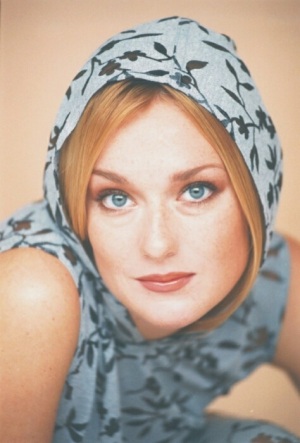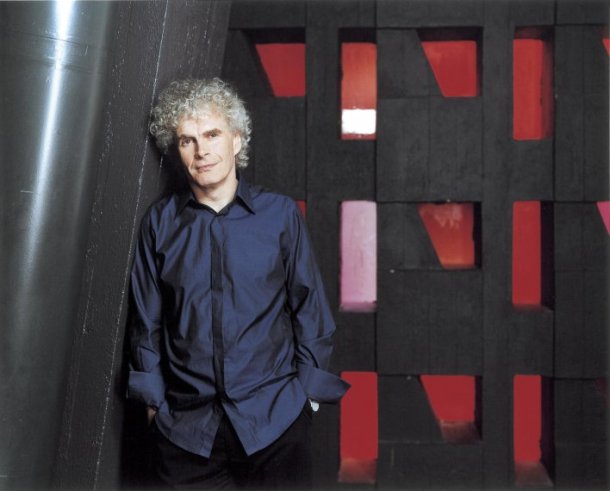There was a time not too long ago that had you mentioned that a fair-haired, mop top, wunderkind conductor was standing on the Los Angeles Philharmonic’s podium, your image would have been of an Englishman rather than a Venezuelan. Simon Rattle (not yet knighted) was Principal Guest Conductor from 1981 to 1994, though as the second half of that tenure progressed, his appearances grew increasingly sporadic. He appeared a precious few more times through the end of the decade. There were some highs (a memorable, dare I say definitive, performance of Beethoven’s Ninth at the Hollywood Bowl), and some lows (a Mahler 4th that included the biggest, most glaring mistake I’ve heard by a professional orchestral musician), and then . . . well, nothing. Nada. Zip. Zilch.
Sure, he had this gig in Berlin to handle, but we were like family here in Los Angeles, right? Apparently, not so much. He had seemingly moved on, with his only U.S. appearances occurring in Philadelphia. He came to Los Angeles during the first decade after the turn of The Millennium, but only to conduct his trusty Berliners.
So it was with much rejoicing that after 12 years away, Sir Simon returned to conduct the LA Phil this past weekend, this time bringing bona fide family along: his wife, mezzo-soprano Magdalena Kožená. Before he even conducted a single note on Friday, he received a loud, prolonged ovation. Clearly, the anticipation was high.
He did not disappoint. Far from it. He kicked some serious ass. I don’t think I’ve heard the orchestra play this well and sound this good in all aspects — technically, lyrically, emotionally — regardless of who was on the podium.
The sound he elicited from the LA Phil was ideal: as bright, transparent, and athletic as it has ever been since it moved into Walt Disney Concert Hall, topped with a ravishing string sound that has evolved and grown into its own over the past few years. Where we usually get more of one style or the other as a given conductor prefers, here we were given both in radiant splendor.
Mr. Rattle used the range of colors and timbres given to him by the orchestra to full effect, and he ended up making a compelling case for a program to which I was not naturally drawn (and if performed by most other conductors, I probably would have avoided). He tied the strange, gossamer sounds of Ligeti’s Atmosphères directly into a lean, lithe take on Wagner’s Prelude to Act I of Lohengrin. It was an unlikely pairing that worked beautifully.
In the second half, he led a Bruckner Ninth Symphony that was richly layered, but crystal clear in form and texture. Climaxes were bold without ever being bombastic. Tempos in the third movement Adagio could get deliberate, but never ponderous. It was as if this Bruckner Ninth had done a P90X workout regimen and come out the other side having lost all the flab and gained much more muscle.
 In the middle of all of this, conductor and orchestra shared the stage with Ms. Kožená as she performed Rückert-Lieder by Mahler. She has a moderately bright tone to her voice, technique to spare, and more than enough power whenever she called upon it. There was much to admire in her singing, though I tended to admire it from a distance: as emotionally invested as she seemed in each song, I would say that I was never drawn in fully. Of course, I also would say that it didn’t prevent me from being impressed and wanting to hear more from her.
In the middle of all of this, conductor and orchestra shared the stage with Ms. Kožená as she performed Rückert-Lieder by Mahler. She has a moderately bright tone to her voice, technique to spare, and more than enough power whenever she called upon it. There was much to admire in her singing, though I tended to admire it from a distance: as emotionally invested as she seemed in each song, I would say that I was never drawn in fully. Of course, I also would say that it didn’t prevent me from being impressed and wanting to hear more from her.
The orchestra and Mr. Rattle gave her a nuanced foundation upon which she could do her stuff, with Marion Kuszyk (oboe d’amore) and Carolyn Hove (English horn) adding luster with their respective solos.
As well as Ms. Kožená sang, the night belonged to Sir Simon. When it was all finished, the crowd gave him four enthusiastic rounds of ovations. The musicians gave the loudest “foot-shuffles-of-approval” I’d ever heard — some were outright stomping — and it was only Friday; I can’t imagine the ovation they’d give him by the final performance on Sunday. He seemed genuinely appreciative of the gestures from audience and musicians. You hated to see it end.
Unfortunately, his visit lasted only one week. He isn’t scheduled for next season, and he’s as in-demand as a conductor can be in the world, so there’s no telling when he’ll come back. Let’s hope that the strength of the performance and the warmth of the reception inspires him to return soon. I don’t think any of us wants to wait another decade.
Random other thoughts:
- There is a lively discussion over on Tim Mangan’s blog, www.ClassicalLife.net, on the topic of applauding at “improper” and/or inopportune times, and how distracting it may or may not be to musicians and other audience members. The general consensus, grossly speaking, is: after big, loud climaxes . . . sure, go for it; at quieter times . . . the reactions are “eh” to “horrible!” At Friday’s concert, there were a couple of instances (once after the third song of the Mahler, another after the first movement of the Bruckner) where a few determined souls insisted on clapping after quiet endings, but interestingly enough sat on their hands during the one splashy ending after the second movement of the Bruckner. Go figure. Anyway, an argument can be made that the mood had been broken, but just as the trans-movement clapping subsided, Mr. Rattle had the orchestra tune up again — and whatever magical mood may have been set had there not been clapping would have been shattered anyways.
- When most guest conductors are leading the orchestra, it’s fairly common for many in the orchestra — including titled players — to take time off. This was not the case Friday; given the number of principals playing (many of them playing the whole concert), you would have thought the Music Director was on the podium.
- There were nine hornists (four of which doubled as Wagner Tubists) during the Bruckner, only four of which are officially on the LA Phil’s roster. Leading the way was Horn Principal Andrew Bain sounding as robust and smooth as ever. What an outstanding addition to the orchestra he has been!
- Speaking of outstanding additions to the orchestra, Tom Hooten was back in the Principal Trumpet chair (for everything but the Mahler, when Jim Wilt sat in the first seat). Officially, he is still a guest, and won’t take over for Don Green full-time until the end of summer.
- I have to make a “Star Wars Day” reference (you know, “May the Fourth be with you”) for this concert because there were more than a few moments when Sir Simon would stand with arms outstretched in front of him, motionless. If ever a conductor looked the part of a Jedi, it was Mr. Rattle in those instances: “Crescendo slightly . . . come in on time . . . these aren’t the droids you’re looking for . . . you can go about your business . . . “

Los Angeles Philharmonic: May 4, 2012; Walt Disney Concert Hall
Sir Simon Rattle, conductor
Magdalena Kožená, mezzo-soprano
Ligeti: Atmosphères
(without pause directly into)
Wagner: Prelude to Act I of Lohengrin
Mahler: Rückert-Lieder
Bruckner: Symphony No. 9
—————
Photo credits:
- Simon Rattle: Sheila Rock/www.simonrattle.de
- Simon Rattle & Magdalena Kožená: Sheila Rock/DG

Say more about the worst mistake you’ve ever heard from a professional orchestral player!
LikeLike
Yes – inquiring minds want to know!!
LikeLike
Everyone has a bad day from time to time, and I’m not trying to embarrass anyone. On top of it, the principal player involved left the orchestra without the LA Phil making any comments about his departure (i.e. no retirement announcement) so I’ll refrain from mentioning names. . . .
There’s an exposed horn line about 6 minutes into the first movement of the Mahler 4th. The player came in a full beat early, and just for good measure, hit a clam along the way. Rattle and orchestra quickly pulled it together and followed along with minimal disruption to the flow. The horn player looked visibly flustered and sounded tense the rest of the night, but got through all four movements.
In the big scheme of things, it could have been worse, and I have no doubts that there were some/many in the audience who didn’t realize it happened. I’ve heard similar mistakes on other days with other pieces (one violin in the section mis-counting in the finale of “Rite of Spring,” trumpets losing their place in the middle of of “LA Variations” when Dudamel was conducting), but those are more “modern,” rhythmically challenging works. This was rhythmically straightforward and it’s a pretty big entrance, so that’s why it sticks out the most in my mind.
It’s so shocking because it is so rare, and humans being humans, I’m shocked that noticeable mistakes don’t happen more often, even at this high a level. NFL and MLB players screw things up more often.
I’m sure there are worse stories out there, especially where the mistake was due to the conductor. I had an LA Phil player tell me that once while on tour, Mehta decided an impromptu encore that included trombones (don’t remember exactly what it was); however, there were no trombones on stage and the conductor didn’t realize it until it was too late. When it came time to cue the trombones, Mehta apparently covered his eyes with one hand and pointed to the empty seats with the other. (It’s been a 20+ years since I heard the story, so if I got some details wrong, I’ll apologize in advance).
Other stories from you guys (or anyone else)?
LikeLike
http://www.nobleviola.com/2012/05/09/when-good-minds-go-bad/
LikeLike
LUFU — that’s awesome. Very cool insights, thanks for sharing. Thanks, too, for the shout out!
LikeLike
Ah, thanks! I don’t actually need the player’s name (and a little research would turn it up anyway…). Those things do happen.
pdxvia, thanks for the link to Noble Viola!
One thing one cannot do: get orchestral players to say who the LUFUs and incompetents are.
LikeLike
Oh, they’d almost never say it on the record (especially because opinions sometimes differ within an orchestra), but there are times . . .
LikeLike
The (in)famous encore with Zubin Mehta was Wagner’s Rienzi Overture.
LikeLike
Pingback: when good minds go bad | NobleViola